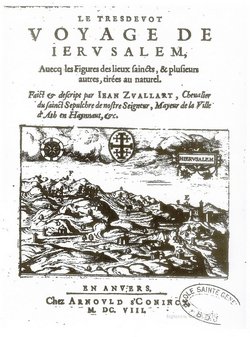By Maurits Biesbrouck, MD. Continued from "Andreas Vesalius’s fatal voyage to Jerusalem (2)". For the first page of this article, click here. |
|
|
This important letter was written in Monzon. Barón Fernández points out that it must date from the 24th of January, at the latest, as the monarch then left Monzon, after the sessions of the Cortes of Aragon were over. Vesalius was also in Monzon with the king. The king himself returned in January 1564, to Madrid, arriving there in May. So Vesalius must have received permission for his trip to Jerusalem while in Monzon, situated approximately 240 km from Perpignan, at the French border, while Madrid is 600 km from Perpignan. Presumably Vesalius left Spain directly via Monzon in order to avoid returning to the capital and making the far longer journey to France from Madrid. He definitely cannot have accompanied the king all the way back to the Spanish capital, as he was already in Venice by the 10th of March, as we shall see in the second letter. But first some other important remarks. It is hard to imagine that the ultra-Catholic king would have written about Vesalius, to his ambassador, in such terms, if he had been condemned by the Inquisition, let alone, if he himself had had to intervene to protect him from the death penalty. If any of this had been true, we may suppose that the king would have expressed himself very differently. Second, the letter also undermines any claim that there was an ambivalent relationship between Vesalius and his king. Third, Philip II is apparently concerned about Vesalius’s welfare and takes safety measures. This was in no way excessive, as Jean Zuallart describes this journey as one of the most dangerous (10). Fourth, it is striking how Philip II expressly asks his ambassador to urge Vesalius to return swiftly. He will probably also have asked him this in person in Monzon, at the point when he gave him his permission to depart. It is just as if he was not entirely relaxed about the matter. |
|
| Letter 2: from Garcihernandez to Philip II
The second letter is the reply of Garcihernandez to the king, on March the 13th. Its translation reads: “Doctor Vesalius arrived here on the tenth of this month, and in order not to waste any time during his journey will, when conditions are favourable, sail from here to Cyprus, and will travel very well equipped, and in company, to Jerusalem. He says that he will travel as swiftly as possible. Ambassador Paulo Tiepolo and a brother of Giovanni Soranzo have very kindly helped him, to comply with [the wish of] Your Majesty. … Venice, the 13th of March 1564.” Signed: “Garcihernandez”. So, in this letter Garciherandez states, that Vesalius had arrived in Venice on March the 10th, and would be sailing from there to Cyprus, with the support of several people. He stresses that no time will be wasted, and that he has conveyed to Vesalius the king’s wish that he should return as soon as possible. The theory that Vesalius used the journey, so that he could afterwards travel to Padua, seems to be undermined here, by the reply of Vesalius from Venice - albeit given indirectly -, that he will return to the royal court, as soon as possible. Letter 3: also from Garcihernandez to Philip II Fifteen days later, on March the 28th, ambassador Garcihernandez sent the king another letter, with only a short passage on Vesalius. Here we read in translation: “Five hundred soldiers are being sent to Cyprus and a hundred to Corfu. The ships have remained in port because of the adverse weather, and Doctor Vesalius will be sailing in one of them, as I wrote to your Majesty...” This short fragment means that Vesalius was still in Venice on March 28th, and that he was only waiting for better weather to embark. |
|
Article continued here: Andreas Vesalius’s fatal voyage to Jerusalem (4). Sources and author's comments: |
|
| MTD Main Page | Subscribe to MTD |
